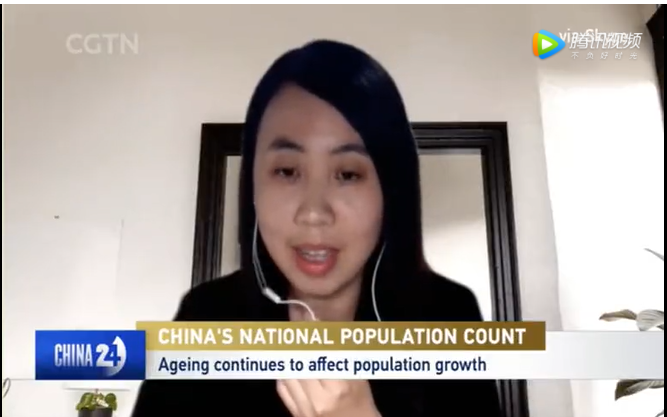文章由公众号“严肃的人口学八卦”授权转载,微信号(renkou8gua)
2021年5月11日,受全世界瞩目的中国第七次人口普查数据公布。总人口规模、人口增长、性别比、低生育率、老龄化成为热点话题。中国人民大学人口与发展研究中心李婷教授接受中国国际电视台China 24栏目采访,对相关数据进行解读。

Q1
本次报告显示过去十年人口增速持续减缓,您怎么看待这个增率?持续减缓的主要原因有哪些?
“七普”数据显示,中国人口仍然在持续增长,但是人口增长率减缓,中国很快将迎来人口负增长时代,甚至比联合国预测和很多权威机构的人口预测负增长年份都来得更早。
Although we still see a positive growth of total population in China, the population growth rate has been largely slowed down and approaches to the critical turning point during the past ten years. According to the projections of UN and other authority organizations, the Chinese population may start to decline (or go negative growth as we call) before 2030, but as suggested by today’s release, the moment may come sooner than the early expectation.
实际上,中国内在人口增长率在上世纪90年代就由正转为负,我们可以形象地将中国人口增长的过程理解为一辆正在行驶的汽车,虽然在九十年代就踩了刹车(也就是总和生育率降到更替水平以下),但是因为惯性作用,车还将持续跑一段时间才会停下来,届时将开启人口负增长。
We observed a dramatic decline of birth numbers in recent years, but the decisive moment occurred as early as 30 years ago. If we use the metaphor that the population growth process is like a running car, we already pressed the brake in 1990s when every woman had less than 2 children by average, but the car continued to slide for a while before it completely stops. Now we are approaching the stop point.
长期的低生育水平是人口负增长的原因。较低的生育水平和生育意愿主要的原因有,随着社会经济发展,孩子的经济效用下降,人们的生育观念也随之发生了变化。同时,年轻夫妇还面临生育养育的一系列限制,比如职场上的竞争压力,居高不下的房价,养育孩子的巨大经济压力等。
In short, the times of negative population growth is coming soon and the underlying mechanism is the long-term low fertility rate. There are varying reasons for the low fertility desire. As the social and economic development go on, the attitude towards children has changed and the children’s economic utility is declining. On the other hand, young couples encounter big constraints that prevent them from having children, such as the high competition pressure, elevated housing price, and the heavy burden of child rearing.
Q2
这次结果显示2020男女比例总性别比跟2010大概持平,新生儿性别比仍高达111,但对比2010已经下降近7%。您对中国的人口性别比现状是否满意?性别失衡长远来说会带来什么严重的后果?
在过去的十年里,国家对于出生性别失衡问题的治理成效显著,家庭的生育观念也发生了缓慢的转变,男孩偏好减弱,我们看到一个可喜的变化趋势——出生性别比稳步下降。但是出生性别比仍然处于偏高的状态,性别失衡问题的治理还有很长的路要走。
I have to say, in the past ten years, the government has made great efforts to reduce the sex ratio at birth, and the society also has a significant progress in gender equity. We are seeing a good changing trend, but the normal sex ratio at birth is between 106 and 107. That means, there is still way to go. I think overall we are on a good track.
性别比失衡会有一系列社会后果,比如劳动力市场的性别失衡可能会改变产业结构、加剧经济的脆弱性。大量的男性找不到配偶,无法结婚,这可能会影响社会稳定,比如出现性犯罪、拐卖女性、买卖婚姻等影响社会和谐的违法行为。大规模剩男的存在也可能会进一步降低生育水平,给未来社会养老带来沉重负担,对未来养老服务体系提出了挑战。
There are several consequences of unbalanced sex ratio.First, it would ruin the gender structure of labor market and affect the economic vitality.Second, there would be a considerate number of left men who cannot find a wife. It would lead to social in-stability, such as sex crime, trafficking women and marriage. Finally, those large number of left men will further reduce fertility level and present a challenge that who can take care of them when they grow old. That is a big burden.
Q3
中国社会迈入人口老龄化,您认为政府应该做些什么来解决低生育率 及其带来的一系列问题?
首先,政府应该创造稳定的就业机会,制定相关政策解决青年人的住房问题,以提高青年人结婚意愿和生育意愿。第二,政府帮助家庭降低养育成本,比如提供3岁以下孩子的托幼服务,减轻家庭在孩子教育上的焦虑。第三,建立一种友好的生育文化,促进性别平等,促进生育并不是提倡女性回归家庭,而是想办法帮他们平衡工作和家庭。
Well, the government should first create stable employment opportunities and provide affordable housing that increase the desire of young people of getting marry and having children. Second, the government should reduce the overall cost of child-rearing, including provide affordable daycare service for children under 3 years old, and relieve parents’ anxiety of children’s education. Third, we should pay attending to build a positive fertility culture and advance the gender equity. That is to say, we are not bringing women back to home, but help them balance work and family.
短时间内,生育率的提高是非常难的,人口老龄化趋势也不可逆转,人口负增长时代即将到来。我们应该更有耐心,做出一些制度安排,准备迎接人口新时代。
However, I have to say even we do everything right, it is very difficult promote the fertility rate in a short time and even there is a significant reverse of fertility rate, we cannot stop population ageing and negative population growth in the near future. We have to be patient and prepare a grand new institutional arrangement to adapt to the new population situation.

